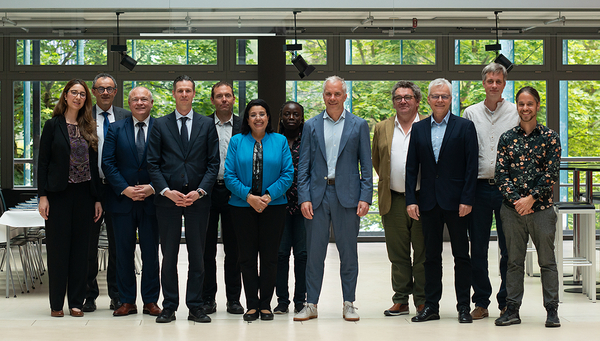News Detail
Applied nuclear research: Deputy Director General of the IAEA is visiting Eawag
June 21, 2024 |
Shortly before 10 o’clock yesterday, Najat Mokhtar arrived at Forum Chriesbach with her entourage. Director Martin Ackermann and other Eawag researchers welcomed her. Among the visitors were Matteo Fachinotti, the Swiss ambassador to the IAEA in Vienna, as well as representatives of the Swiss Federal Office of Energy (SFOE), the Swiss Agency for Development and Cooperation (SDC) and the Spiez Laboratory. After getting to know each other, the programme included a presentation of the “miniRUEDI” mobile mass spectrometer developed at Eawag – as well as a tour of the wastewaster-based epidemiology lab. Mokhtar’s visit marks the start of her two-day stay in Switzerland, which the SFOE has organised in the context of applied nuclear research. The visit will continue today (Friday) at the Spiez Laboratory.
Eawag has been working with the IAEA since 2019 and signed a practical arrangement in 2022. The collaboration is based on two pillars: the global monitoring network for water isotopes as well as noble gas analysis of groundwater. The SFOE initiated the cooperation and supported it financially.
Protecting groundwater using radioactive isotopes
Water molecules containing the weakly radioactive water isotope tritium are used as tracers in hydrogeology, for example to analyse the age, origin and dynamics of groundwater resources and to track climatic changes.
The IAEA has been operating a global monitoring network for water isotopes in groundwater since the 1960s - a huge treasure trove of data collected from all over the world. Based on this, Eawag researchers led by Michael Berg from the W+T department are creating geographical maps that can predict where groundwater is particularly vulnerable to surface pollution. This work provides important knowledge for the sustainable use of groundwater resources.
What trace gases tell us about groundwater
In their collaboration, the IAEA and Eawag are also focussing on the analysis of noble gases in groundwater. Rolf Kipfer's laboratory in the W+T department is one of the world's leading facilities for this specialised measurement technology. Co-funded by the SDC, the IAEA aims to use the “miniRUEDI”, among other things, to make highly precise statements about the presence of trace gases such as helium in groundwater. This data allows conclusions to be drawn about where and how much new groundwater is being created – important information given how many people around the world do not have access to sufficient clean water.
Atoms for Peace
The International Atomic Energy Agency is the world's central intergovernmental forum for scientific and technical cooperation in the nuclear field. It works for the safe, secure and peaceful uses of nuclear science and technology, contributing to international peace and security and the United Nations' Sustainable Development Goals.

